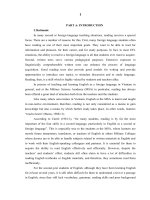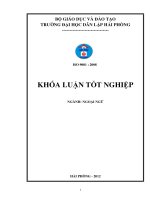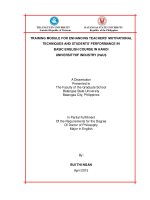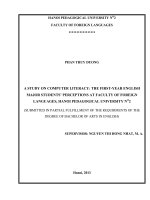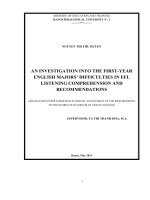Difficulties in using references which 2nd year English majors face when doing secondary research (SR) in Hanoi University ppt
Bạn đang xem bản rút gọn của tài liệu. Xem và tải ngay bản đầy đủ của tài liệu tại đây (1.02 MB, 8 trang )
Difficulties in using references which 2
nd
year English majors
face when doing secondary research (SR) in Hanoi University
I. Introduction
Doing secondary research in term 3 at Hanoi University is challenging work
for students because it is an important kind of writing in tertiary level which requires
students move from essays to research papers. One remarkable thing in doing this task
is that it needs their ability to work with sources. Each main point will be stronger if it
is backed with good supporting references. However, using references is not
considered as an easy task. It includes many steps such as finding, evaluating and
integrating (integrating references means that you combine your sources with your
own ideas by quoting, paraphrasing, and summarizing). And despite the fact that a
large number of students encounter obstacles, few studies have been conducted about
this subject. In fact, it is very necessary for them to take a closed look at this. Within
the scope of our project, we investigated difficulties in using references which 2
nd
English majors face when doing secondary research to clarify what makes it hard.
II. Materials and Methods
In order to gather data for our study, a questionnaire (see Appendix) was
designed. The very first question is to identify students’ opinion about using
references. The next question is mentioned about common places where they often
gain information for secondary research. Whereas, the third and forth aim to probe
difficulties in finding references. The subsequent one concentrates on difficulties in
evaluating references. Lastly, the rest of questions are figured out difficulties in
integrating references.
1
Second-year English students at Hanoi University were participants of our
research. 30 students were chosen randomly from different classes. Most of them are
female and at the age of 20 on average. Their attendance was purely voluntary.
The survey was implemented in Hanoi University in April, 2009. The
questionnaires were distributed to the participants in each class in the break time.
Firstly, the students read the questions carefully. Then they were explained with some
unclear points. They fulfilled the questionnaires for 30 minutes. After that, we
collected all the handouts.
III. Results and Discussion
In general, almost students consider using references as a difficult task. The
fact is that 70% of asked students find it difficult, 30% of them find it normal and no
one finds it easy. In this study, the distribution of facts relate to difficulties in using
references is conducted. It will make clear why students feel it difficult.
1. Difficulties in finding references
1.1 Time consuming
Table 1: Time consuming to find references
Spending time Not much Much Very much
The number of respondents 1
3%
20
67%
9
30%
The first things we figure out about difficulties in finding references are time
consuming. When being asked about time, 20 of 30 respondents answer that they
spend much their time on finding references, 9 of 30 respondents spend very much
their time on that and only 1 person report that finding materials does not cost their
time much. These numbers indicate that finding material is a task which require much
2
time. Masson stated, “There are seventy million books in American libraries, but the
one I want to read is always out” (As cited in Atkinson, R. H. (1999), p.416). Hence,
to follow by a set amount of time for writing is not easy for them.
1.2 Other difficulties
Because writing a research paper is not limit the data resources, participants
can look for materials from a variety of sources. However, the majority of their
information gathering is found in Hanu’s library (42%) and on the Internet (47%).
Only some percentage they report that they have information from friends, teachers or
other people (8%) and have materials from other libraries (3%). Based on this
numbers, we can focus on the difficulties of finding materials in Hanu’s library and on
the Internet. To be more specific, we categorize difficulties into printed sources
(mainly in document room of Hanu’s library) and electronic sources (mainly on the
Internet).
1.2.1 Difficulties in document room of Hanu’s library
Bar-chart 1: Frequency of facing obstacles in document room
It can’t be denied that many students have troubles with printed source in
Hanu’s library. As illustrated in bar-chart 1, the students’ responses show how often
they face with “shortage of materials” and “being unable to find relevant materials”.
3
A half of respondents (50%) often face with shortage of materials, 12 respondents
(40%) sometimes face with shortage of materials and only 3 respondents (10%) rarely
face with shortage of materials. There is no stick that fall into “never”. This number
indicates that shortage of materials is difficult for more than half of respondents.
Moreover, the percentage of students having problem with finding relevant materials
is higher than shortage of materials. More than a half of respondents (57%) are
sometime not able to find relevant materials and 40% of them are often unable to find
relevant materials. These difficulties are mentioned above associated with the variety
books in library and students’ ability to work with sources.
1.2.2 Difficulties on the Internet
Bar-chart 2: Frequency of facing obstacles on the Internet
As be shown in bar-chart 2, lack of computer skills is not big problem
compare to problem with some websites and slow internet connection, 47%
sometimes, 40% rarely and 13% never face with. Trouble with some websites (such as
messy, inaccessible and unprinted) and slow internet connection seem have the same
rate. There were only 5 respondents (17%) rarely meet these obstacles, the rest of
4
them (83%) sometimes or often meet. Searching Internet hides some obstacle which is
hard to avoid. Messy website is an example for that. “The Web is messy in that it
cannot always provide clear directions on how to get where we want to go. The
hyperlinks that exist among different Websites often send people on a trip to nowhere
or somewhere totally unexpected” (Herd, 2006). And for some websites, students are
asked for money to access. In addition, some website they can access but they cannot
copy or print. Finally, slow internet connection is problem wide common. In the
computer lab, because there are a large number of students accessing Internet at the
same time, Internet connections are sometimes slow. The fact is that the more people
access Internet in the same network, the more slowly it is.
2. Difficulties in evaluating references
Table 2: Frequency of facing obstacles in evaluating
How often do you face with these
following obstacles when evaluating
references?
Never Rarely Sometimes Often
Have a lot of new words 0 3 21 6
Not fully understand author’s opinion 1 4 20 5
Gather out-of-date materials 1 9 18 2
Gain one-sided materials 0 7 19 4
Take too much time to read 1 2 6 21
The table above shows how frequency students face when evaluating
references. As we can see, a number of respondents answer that they are “sometimes”
and “often” for “have a lot of new words”, “not fully understand author’s opinion”,
“gather out-of-date materials”, “gain one-sided materials” and “take too much time
to read” are 27, 25, 20, 23 and 27, respectively. And these are big number for each
category.
In doing secondary research, students have to gain many materials. But “not
every thing that is published is accurate, worthy of your respect, or credible”
5
(Benander, 1999, p.306). Hence, that they sometimes and often meet these obstacles
cannot avoid. References with relevant time will be more persuading the readers and
one-sided materials can make the readers go another ways. Therefore, they have to
spend time to care about that. If the materials have many new words, surely, they have
to spend more time to read. Particularly, if they read carelessly, they can
misunderstand author’s opinion.
3. Difficulties in integrating references
3.1 Difficulties in avoiding plagiarism
Bar chart 3: Plagiarism
Plagiarism (using sentences or ideas of an author without acknowledging) is
not a strange thing with students. As shown in bar chart 3, sometimes makes up the
highest percentage (70%), follows by rarely (17%), often (13%) and never (0%).
Students use paraphrase most (50% of respondents apply paraphrase most when
integrating) but they still use sentences or ideas of an author without acknowledging.
It means that students are based on the reference materials too much. To avoid
plagiarism in this situation is wide difficult for students. It requires the whole progress
of learning and the important thing is that students have to be aware of avoiding
plagiarism.
6
3.2 Other difficulties
Bar-chart 4: Frequency of facing obstacles in integrating
No respondents answers that they don’t face with lack of vocabulary and
grammar. They meet these obstacles rarely (17%), sometimes (63%) or often (20%).
Benander (1999) said that “The greater the variety of words the writer knows, the
greater the ability he or she has to express an idea exactly and completely” (p.266)
and “Grammar is perhaps the most intimidating concept a student of writing faces”
(p.23). In fact, students need use vocabulary and grammar to express authors’ ideas in
their own words, to introduce references in research. Therefore, that up to 83% of
respondents sometimes and often face with lack of vocabulary and grammar is
absolutely clear factor which cause difficulty in integrating references.
Additionally, being afraid of making mistakes is another difficulty of students
which account for sometimes (30% of respondents) and often (30%). Students scare
making mistakes means that they scare integrating and writing. “Almost all writers at
some time suffer from a fear of writing or a feeling of being unable to write”
(Benander, 1999, p.2). This may call is difficulty of concentration.
7
Moreover, 40% of students often face with difficulties in finding main ideas
when summarizing equal to rate of sometimes. This difficulty is easy to understand
because when summarizing, they need report the work of others without unnecessary
detail.
IV. Conclusion
In brief, with this project, we carried out the difficulties in finding, evaluating and
integrating references in doing secondary research of second English majors at Hanoi
University. It is obvious that using references in doing secondary research is no easy
task. However, this survey does not give students obstacles which make them feel
difficult to use references. It makes student pay attention to difficulties to be careful
when using references not only in doing secondary research but in other research as
well. Our project was done on small scale and small aspect so cannot void some
limitations. We hope that further research will be done to enlarge this topic.
Word count: 1610
8
